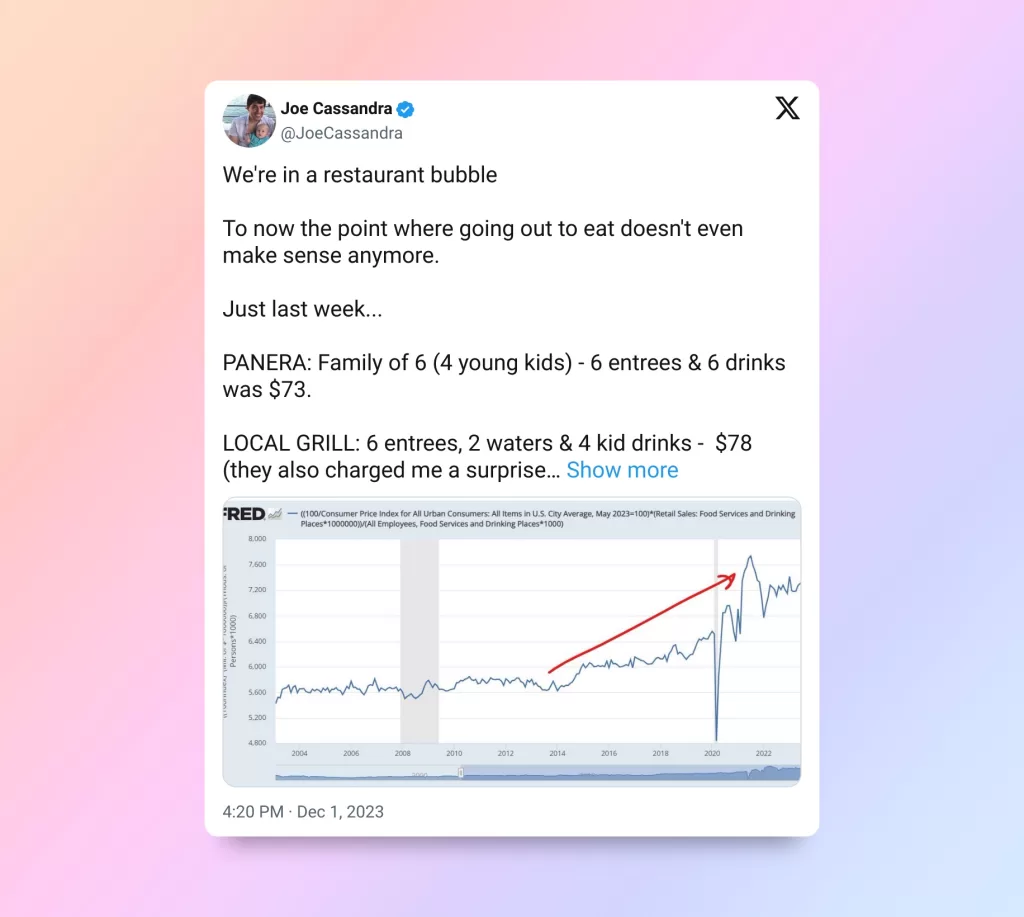How Japan Keeps Food Costs Low While Prices Skyrocket Elsewhere
As food costs soar around the world, Japan remains an oasis of affordability. A tweet recently went viral detailing astronomical restaurant bills in the US, lamenting how going out to eat no longer makes financial sense. Meanwhile, Japanese meals are known for their reasonable prices, often cheaper to eat out than cook at home.

His key points:
@JoeCassandra
- PANERA: Family of 6 (4 young kids) – 6 entrees & 6 drinks was $73.
- LOCAL GRILL: 6 entrees, 2 waters & 4 kid drinks – $78 (they also charged me a surprise 3% fee for using a CC)
- Effing iHOP: 2 bfast sandwiches, 4 plates of kids pancakes, 4 chocolate milks – $60 lol (doesn’t a pancake cost $0.10 to make)
- Even Chick Fil A is $55+ for each trip.
This affordability stems in part from Japan’s struggle to achieve its 2% inflation target over the past 25 years. While countries worldwide grapple with skyrocketing inflation, Japan’s inflation rate stood at just 3% in August 2022. Several factors contribute to Japan’s low inflation and relative affordability compared to other major economies:
Competition Drives Low Prices
Fierce competition among Japan’s fast food chains and convenience stores drives prices down. For instance, the price of a bowl of ramen has barely budged over decades despite rising costs, leading some ramen shops to close down. Convenience store chains like 7-Eleven and FamilyMart entice customers with budget-friendly ready-to-eat meals. You can typically get a meal for around $3.
Cheap Groceries
Grocery stores like Gyomu Super offer rock-bottom prices on fresh produce and pantry staples. Even discounting the time and effort spent cooking, buying ingredients from these no-frills grocers is usually cheaper than cheap restaurant meals.
Slow Pandemic Reopening
While many countries reopened swiftly, Japan gradually lifted COVID restrictions. This delayed resurgence in consumer demand that fueled inflation elsewhere.
Negative Interest Rates
Six years of negative interest rates in Japan disincentivized saving and encouraged spending, but chronically weak demand and an aging, declining population blunted their impact. Japan’s labor force participation has plunged as the population shrinks and ages.
Cultural Affordability
Japanese convenience stores gained immense popularity by catering to overworked and time-poor customers with reasonably priced, fresh, 24/7 meal options. More broadly, Japanese food culture values accessibility, quality, and restraint in pricing.
So while the yen continues weakening and global instability threatens prolonged inflation, Japan’s institutional structures and cultural norms around food pricing inject much-needed affordability. Japanese curb hyperinflationary pressures through regulations, competition policies, centralized buying for staple imports like wheat, and a conservative post-pandemic reopening.
For cost-of-living weary residents and visitors, Japan remains an island of stability where dining out doesn’t necessarily break the bank. From conveyor belt sushi to beef bowls layered atop rice, tasty Japanese fare can still be had on a budget.